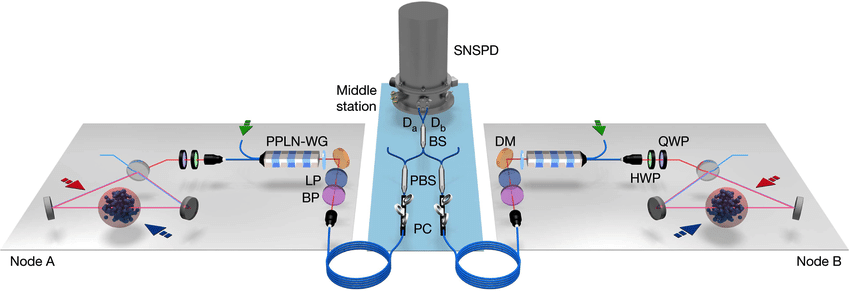Efforts to develop the necessary capabilities for building a practical ‘quantum-based’ internet have been ongoing for years. One of the biggest challenges is being able to maintain and manage entanglement of remote quantum memories over great distances. Last week a group of researchers from University of Science and Technology of China reported in Nature having successfully entangled quantum memories made from atomic ensembles and maintained entanglement over 22 kilometers of “field-deployed fiber” and 50 kilometers of coiled fiber in a lab.
This achievement of city-scale distance ‘transmission’ over fiber using atomic ensembles as quantum memory is a first and is catching attention. There’s an account of the work posted on New Scientist noting, “Individual photons have been entangled across distances exceeding 1000 kilometres, but for larger systems of particles, which hold more information, maintaining this entanglement is harder.” In their work, the researchers used ensembles of ~100 million cooled rubidium atoms in a vacuum chamber as quantum memory.
The use of atomic ensembles for quantum memory has been an active area for some time and presents characteristics that enhance on-demand entanglement but also are challenging to manage. The details of the newly reported approach are best read directly from the paper (Entanglement of two quantum memories via fibres over dozens of kilometres). In brief, the researcher created two separate ‘memory’ nodes in the same lab and were able to entangle them in a way not unlike what would be needed for signal repeater in a quantum internet. This excerpt is from the paper:
“A quantum internet that connects remote quantum processors should enable a number of revolutionary applications such as distributed quantum computing. Its realization will rely on entanglement of remote quantum memories over long distances. Despite enormous progress, at present the maximal physical separation achieved between two nodes is 1.3 kilometres, and challenges for longer distances remain. Here we demonstrate entanglement of two atomic ensembles in one laboratory via photon transmission through city-scale optical fibres.
“The atomic ensembles function as quantum memories that store quantum states. We use cavity enhancement to efficiently create atom-photon entanglement and we use quantum frequency conversion to shift the atomic wavelength to telecommunications wavelengths. We realize entanglement over 22 kilometres of field-deployed fibres via two-photon interference and entanglement over 50 kilometres of coiled fibres via single-photon interference. Our experiment could be extended to nodes physically separated by similar distances, which would thus form a functional segment of the atomic quantum network, paving the way towards establishing atomic entanglement over many nodes and over much longer distances.”
Shown below is a diagram of the experiment and caption from the paper.

The researchers note their work is an important first step and discuss next steps: “Extending these experiments to nodes separated by much longer distances will enable us to perform advanced quantum information tasks, such as efficient quantum teleportation over long distances. By incorporating more quantum memories, our experiment may be extended to entangle multiple quantum memories over long distances via multi-photon interference. One may also create two pairs of remote atomic entanglement over sub-links and extend the distance of atomic entanglement via entanglement swapping, following the quantum repeater scheme. Concatenating this process could extend the distance sufficiently to beat the limit of direct transmission.”
Link to New Scientist article written by Leah Crane: https://www.newscientist.com/article/2233317-record-breaking-quantum-memory-brings-quantum-internet-one-step-closer/#ixzz6EVDW1B4F
Link to Nature paper: https://www.nature.com/articles/s41586-020-1976-7.epdf




























































